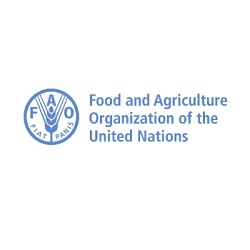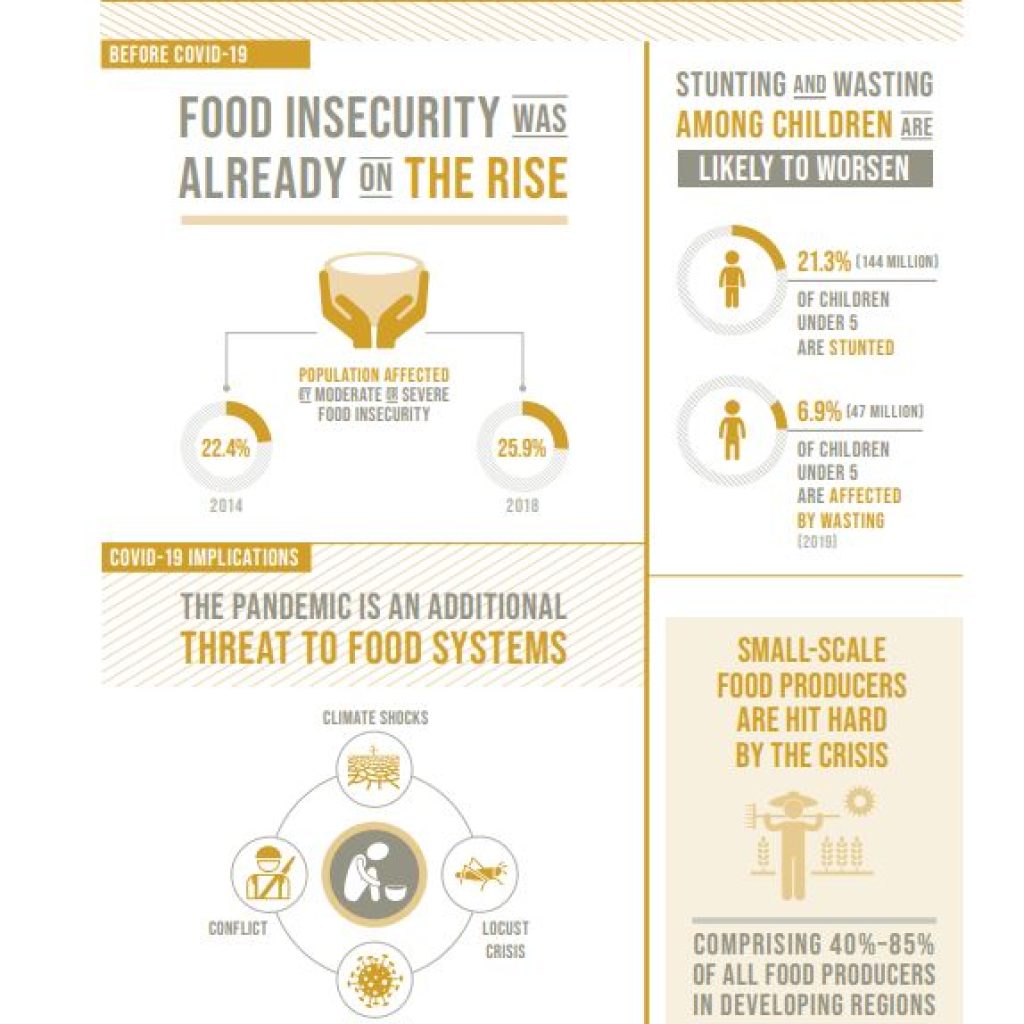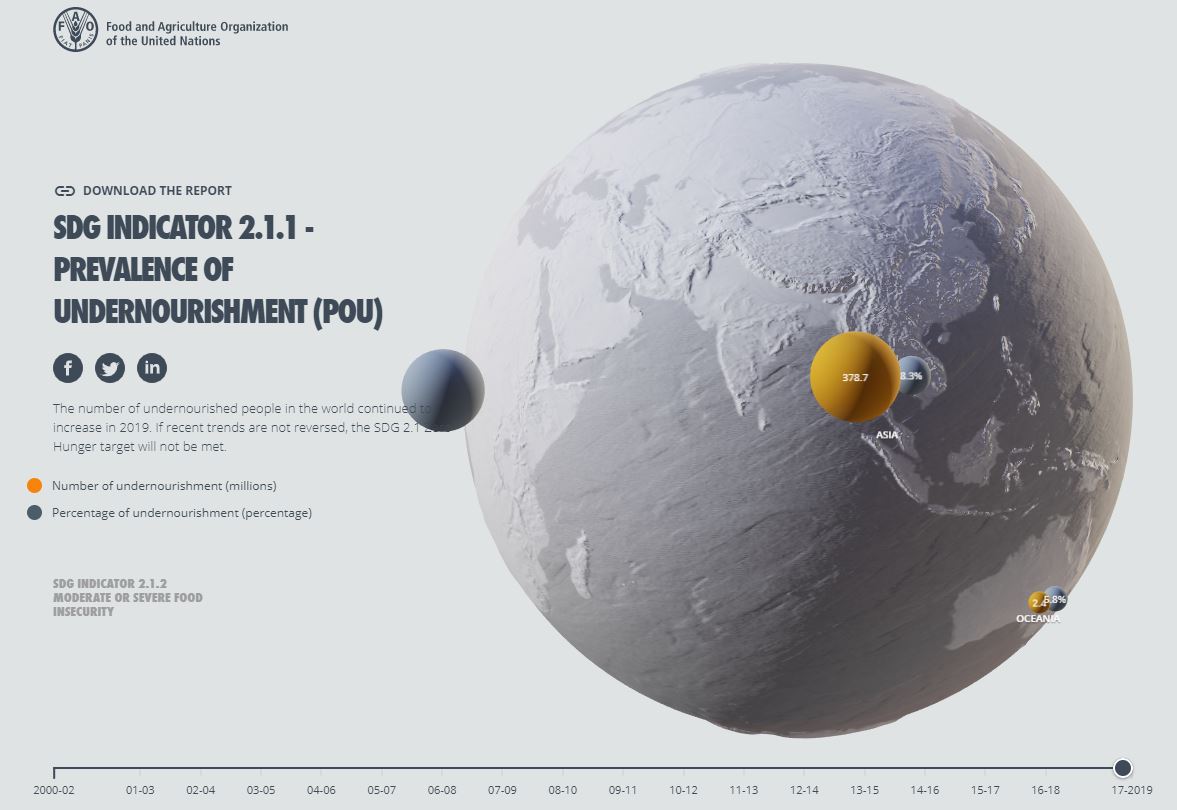16th of October 2020, all UN member states.
After decades of steady decline, world hunger has slowly been on the rise since 2015. An estimated 821 million people in the world suffered from hunger in 2018. If nothing changes, the immense challenge of achieving the Zero Hunger Target by 2030 will not be achieved. At the same time, overweight and obesity continue to increase in all regions of the world, according to The State of Food Security and Nutrition in the World 2020
Five years into the 2030 Agenda, it is time to assess progress and to question whether continuing efforts implemented thus far will allow countries to reach SDG 2 targets.
This year’s report complements the usual assessment of the state of food security and nutrition in the world with projections of what the world may look like in 2030 if trends of the last decade continue. Importantly, as the COVID-19 pandemic continues to evolve, this report attempts to foresee some of the impacts of this global pandemic on food security and nutrition. However, given that the full extent of the devastation that COVID-19 will cause is still largely unknown, it is important to recognize that any assessment at this stage is subject to a high degree of uncertainty and should be interpreted with caution.
Progress towards hunger and food insecurity targets
The three most recent editions of this report already presented evidence that the decades-long decline in hunger in the world, as measured using the prevalence of undernourishment (PoU), had unfortunately ended. Additional evidence and several important data updates, including a revision of the entire PoU series for China back to 2000, show that almost 690 million people in the world (8.9 percent of the world population) are estimated to have been undernourished in 2019. Revision in light of the new data, which results in a parallel downward shift of the entire global PoU series, confirms the conclusion of past editions of this report: the number of people affected by hunger in the world continues to increase slowly. This trend started in 2014 and extends to 2019. There are nearly 60 million more undernourished people now than in 2014, when the prevalence was 8.6 percent – up by 10 million people between 2018 and 2019.
The reasons for the observed increase of the last few years are multiple. Much of the recent increase in food insecurity can be attributed to the greater number of conflicts, often exacerbated by climate-related shocks. Even in some peaceful settings, food security has deteriorated as a result of economic slowdowns threatening access to food for the poor.
The evidence also reveals that the world is not on track to achieve the SDG 2.1 Zero Hunger target by 2030. Combined projections of recent trends in the size and composition of the population, in the total food availability, and in the degree of inequality in food access point to an increase of the PoU by almost 1 percentage point. As a result, the global number of undernourished people in 2030 would exceed 840 million.
Key Messages
Updates for many countries have made it possible to estimate hunger in the world with greater accuracy this year. In particular, newly accessible data enabled the revision of the entire series of annual undernourishment estimates for China back to 2000, resulting in a substantial downward shift of the series of the number of undernourished in the world. Nevertheless, the revision confirms the trend reported in past editions: the number of people affected by hunger globally has been slowly on the rise since 2014.
Current estimates are that nearly 690 million people are hungry, or 8.9 percent of the world population – up by 10 million people in one year and by nearly 60 million in five years. The number of people affected by severe food insecurity, which is another measure that approximates hunger, shows a similar upward trend. In 2019, close to 750 million – or nearly one in ten people in the world – were exposed to severe levels of food insecurity.
Considering the total affected by moderate or severe food insecurity, an estimated 2 billion people in the world did not have regular access to safe, nutritious and sufficient food in 2019.
The world is not on track to achieve Zero Hunger by 2030. If recent trends continue, the number of people affected by hunger would surpass 840 million by 2030.
A preliminary assessment suggests that the COVID-19 pandemic may add between 83 and 132 million people to the total number of undernourished in the world in 2020 depending on the economic growth scenario.
Globally, the burden of malnutrition in all its forms remains a challenge. According to current estimates, in 2019, 21.3 percent (144.0 million) of children under 5 years of age were stunted, 6.9 percent (47.0 million) wasted and 5.6 percent (38.3 million) overweight.
The world is making progress but is not on track to achieve the 2025 and 2030 targets for child stunting and low birthweight, and for exclusive breastfeeding, is on track only for the 2025 target. The prevalence of wasting is notably above the targets. Most regions are not on track to achieve the targets for child overweight. Adult obesity is on the rise in all regions. Urgent action is needed to reverse these upward trends.
The nutritional status of the most vulnerable population groups is likely to deteriorate further due to the health and socio-economic impacts of COVID-19.
Food insecurity can worsen diet quality and consequently increase the risk of various forms of malnutrition, potentially leading to undernutrition as well as overweight and obesity.
Low-income countries rely more on staple foods and less on fruits and vegetables and animal source foods than high-income countries. Only in Asia, and globally in upper-middle-income countries, are there enough fruits and vegetables available for human consumption to be able to meet the FAO/WHO recommendation of consuming a minimum of 400 g/person/day.
While we still face significant challenges in just accessing food, challenges are even more important in terms of accessing healthy diets. Healthy diets are unaffordable to many people, especially the poor, in every region of the world. The most conservative estimate shows they are unaffordable for more than 3 billion people in the world. Healthy diets are estimated to be, on average, five times more expensive than diets that meet only dietary energy needs through a starchy staple.
The cost of a healthy diet exceeds the international poverty line (established at USD 1.90 purchasing power parity (PPP) per person per day), making it unaffordable for the poor. The cost also exceeds average food expenditures in most countries in the Global South: around 57 percent or more of the population cannot afford a healthy diet throughout sub-Saharan Africa and Southern Asia.
All diets have hidden costs, which must be understood to identify trade-offs and synergies in relation to other SDGs. Two hidden costs that are most critical relate to the health (SDG 3) and climate-related (SDG 13) consequences of our dietary choices and the food systems that support these.
Under current food consumption patterns, diet-related health costs linked to mortality and non-communicable diseases are projected to exceed USD 1.3 trillion per year by 2030. On the other hand, the diet-related social cost of greenhouse gas emissions associated with current dietary patterns is estimated to be more than USD 1.7 trillion per year by 2030.
Shifting to healthy diets can contribute to reducing health and climate-change costs by 2030, because the hidden costs of these healthy diets are lower compared to those of current consumption patterns. The adoption of healthy diets is projected to lead to a reduction of up to 97 percent in direct and indirect health costs and 41–74 percent in the social cost of GHG emissions in 2030.
However, not all healthy diets are sustainable and not all diets designed for sustainability are always healthy. This important nuance is not well understood and is missing from ongoing discussions and debates on the potential contribution of healthy diets to environmental sustainability.
To increase the affordability of healthy diets, the cost of nutritious foods must come down. The cost drivers of these diets are seen throughout the food supply chain, within the food environment, and in the political economy that shapes trade, public expenditure and investment policies. Tackling these cost drivers will require large transformations in food systems with no one-size-fits-all solution and different trade-offs and synergies for countries.
Countries will need a rebalancing of agricultural policies and incentives towards more nutrition-sensitive investment and policy actions all along the food supply chain to reduce food losses and enhance efficiencies at all stages. Nutrition-sensitive social protection policies will also be central for them to increase the purchasing power and affordability of healthy diets of the most vulnerable populations. Policies that more generally foster behavioural change towards healthy diets will also be needed.
SDG Indicator 2.1.1 - Prevalence of Undernourishment (PoU)
The interactive indicator map shows the number of undernourishment (in millions) and percentage of undernourishment.
Moreover in the FAO elearning Academy of the Food and Agriculture Organization of the United Nations, there is an online course available which is focused on food insecurity and PoU. The online course can be accessed via this link https://elearning.fao.org/course/view.php?id=386.
Location: all UN member states For more information and detailed program visit the website.
© Food and Agriculture Organization of the United Nations
Published in GI-Mail 10/2020 (German & English edition).
- Do you already know our monthly newsletter GI-Mail with useful tips on postgraduate courses?
Sign up here. - Are you looking for vacancies or new career challenges? Here you will find the latest vacancies and job offers.
- Do you already know our monthly job-information GI-Jobs with current job offers for doctors, managers and nurses? Sign up here.
- Are you interested in up to date postgraduate courses and CME? In our education database »medicine & health« you will find new education events from over 2300 organizers.




